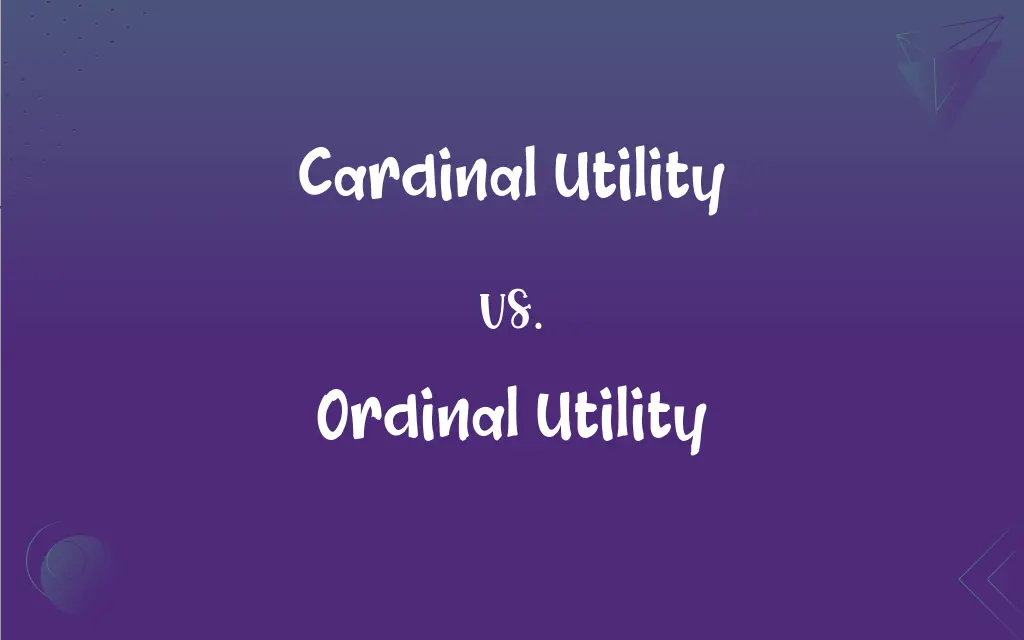Cardinal Utility vs. Ordinal Utility: What's the Difference?
Edited by Janet White || By Harlon Moss || Updated on October 17, 2023
Cardinal utility measures satisfaction in quantifiable units. Ordinal utility ranks preferences without quantifying the difference in satisfaction.

Key Differences
Cardinal utility is a concept in economics that posits that the satisfaction or utility derived from a good or service can be measured in definite, quantifiable units. This means that an individual can specify exactly by how much one bundle of goods is preferred over another. For example, a person might say that having two apples gives them twice as much satisfaction as having one.
Ordinal utility, in contrast, suggests that while individuals can rank their preferences for various bundles of goods, they cannot quantitatively express the intensity or magnitude of their preferences. In this approach, a consumer can say they prefer one bundle to another but cannot definitively state by how much. So, using the same example, a person can say they prefer two apples to one but not necessarily that two apples give them double the satisfaction.
The distinction between cardinal utility and ordinal utility stems from differing views on the measurability of satisfaction or utility. While cardinal utility believes in a more tangible, quantifiable measure, ordinal utility sticks to a more abstract, relative ranking system.
One might wonder why such distinctions matter. In decision-making, cardinal utility can lead to exact mathematical computations and optimizations, often used in classical economics. Ordinal utility, on the other hand, is commonly associated with modern consumer theory, focusing more on preference rankings to determine choice.
Interestingly, despite the conceptual differences, both cardinal utility and ordinal utility aim to understand consumer preferences and choices. They offer different lenses to view the decision-making processes, highlighting either quantitative measures or relative rankings.
ADVERTISEMENT
Comparison Chart
Measurement
Quantifiable units
Relative rankings
Expresses
Exact magnitude of preference
Preference order without magnitude
Associated Economics
Classical economics
Modern consumer theory
Decision-making
Mathematical optimizations
Choice based on preference rankings
Satisfaction Intensity
Can express intensity (e.g., "twice as much")
Cannot express intensity (e.g., "prefer A to B")
ADVERTISEMENT
Cardinal Utility and Ordinal Utility Definitions
Cardinal Utility
A concept believing satisfaction can be numerically expressed.
With cardinal utility, one can say eating two ice creams offers twice the pleasure of one.
Ordinal Utility
A relative measure of a consumer's preference.
Ordinal utility indicates she prefers chocolate to vanilla without specifying the satisfaction gap.
Cardinal Utility
Utility expressed in definite numbers.
The cardinal utility of his new car is 10 units more than his old one.
Ordinal Utility
Utility expressed in terms of rankings.
His ordinal utility list places skiing above hiking and hiking above swimming.
Cardinal Utility
A tangible scale of measuring consumer satisfaction.
Using cardinal utility, she gauged her joy from the concert as a 9 out of 10.
Ordinal Utility
A concept that relies on preference orderings.
With ordinal utility, she ranks movies as first choice, books second, and games third.
Cardinal Utility
A method of measuring utility in quantifiable units.
According to cardinal utility, having $20 provides double the satisfaction of having $10.
Ordinal Utility
A method where utility is ranked without measuring intensity.
According to ordinal utility, he prefers coffee over tea but doesn't quantify how much more.
Cardinal Utility
An exact measure of consumer's preference.
Cardinal utility provides a numeric value to the happiness derived from each purchase.
Ordinal Utility
A qualitative scale for gauging consumer satisfaction.
Using ordinal utility, she can say she likes jazz more than blues, without giving a score.
FAQs
What is the main concept behind cardinal utility?
Cardinal utility believes utility can be measured in quantifiable units.
How does ordinal utility represent preferences?
Ordinal utility represents preferences through relative rankings without quantifying the difference.
Why is cardinal utility often seen as unrealistic?
Because it's hard to give exact numerical values to subjective experiences.
Is ordinal utility associated with modern or classical economics?
Ordinal utility is commonly associated with modern consumer theory.
Is cardinal utility subjective or objective?
It's subjective, as it's based on individual perceptions of satisfaction.
Can ordinal utility tell how much more one prefers A over B?
No, ordinal utility only provides a ranking, not the intensity of preference.
Which utility type is more prevalent in modern economics?
Ordinal utility, as it's more flexible in capturing diverse consumer behaviors.
Can ordinal utility tell us the difference in satisfaction between two choices?
No, it only provides the order of preference.
Is cardinal utility always expressed in monetary terms?
No, it can be any consistent unit of measure, like "happiness units."
Can cardinal utility express preference intensity?
Yes, cardinal utility can express the exact magnitude of preference.
Which utility approach uses a numerical scale?
Cardinal utility uses a numerical scale to express satisfaction.
How do consumers express preferences in ordinal utility?
They rank preferences in order but don't quantify the satisfaction difference.
Is it easier to perform mathematical computations with cardinal utility?
Yes, since cardinal utility provides exact numerical values.
Can ordinal utility be plotted on a graph?
Yes, but it usually represents preference curves without specific utility values.
Which type of utility would use a satisfaction scale from 1-10?
Cardinal utility, as it believes in quantifiable measures of satisfaction.
Why is ordinal utility considered more flexible?
Because it doesn't require quantifying subjective experiences.
How does ordinal utility help in decision-making?
It focuses on preference order, guiding choices based on relative rankings.
What is the main advantage of ordinal utility?
It captures preferences without needing to quantify the often subjective nature of utility.
Can both utility types coexist in economic analyses?
Yes, depending on the study's focus, both types can be relevant.
Does cardinal utility require a common unit of measurement?
Yes, to provide quantifiable measures across different goods or services.
About Author
Written by
Harlon MossHarlon is a seasoned quality moderator and accomplished content writer for Difference Wiki. An alumnus of the prestigious University of California, he earned his degree in Computer Science. Leveraging his academic background, Harlon brings a meticulous and informed perspective to his work, ensuring content accuracy and excellence.
Edited by
Janet WhiteJanet White has been an esteemed writer and blogger for Difference Wiki. Holding a Master's degree in Science and Medical Journalism from the prestigious Boston University, she has consistently demonstrated her expertise and passion for her field. When she's not immersed in her work, Janet relishes her time exercising, delving into a good book, and cherishing moments with friends and family.































































